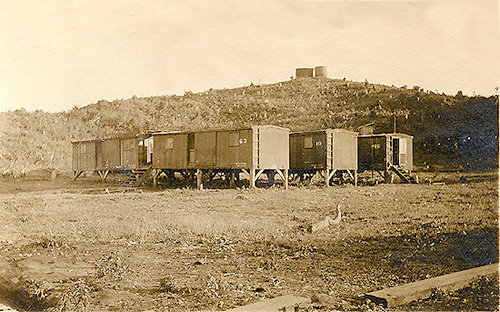|
Early Panama Canal housing! When I came across this photo, I
thought about how everyone used to fight over housing in the Canal
Zone. How about these dwellings? This was common practice
during the construction days to use old box cars to house laborers.
Photo has no date or location mentioned.
After publication note:
Bill:
Kathleen Steiner Bennett here. I have some info on this week's photo
of the week. My grandfather William J. Allen went to Panama in 1908.
Four years later after he "re-upped" twice his wife, Margaret
and 5 children Susan Allen Magee, Margaret Allen Pepe, Walter Allen,
William Allen and Marian Allen Steiner (my mom) followed.
My grandmother told me when the family first went to Panama
they lived temporarily in a box car I believe in the town of Matachin.
As newcomers they were given one half of a box car. The box car was
shared by two families. It was divided by blankets on a wire across
the center. Because there could be no cooking facilities in the box
car they were all given a card to eat at the "mess hall" with
the workers and bachelors. Their box car was home to the two families
until better housing could be provided. There were no sidewalks -
merely planks that were laid end to end to keep the people out of the mud.
Grandma told me that it wasn't very long before they were
given a tiny wooden cottage that was covered with bougainvillea. She
said the house was full of ants and insects because of the bougainvillea
so one day a groundskeeper was cutting the brush and grass around the area
and she asked him to cut down the bougainvillea. When he cut
and pulled the bougainvillea off the house the whole back wall fell down
due to a termite infestation. The bougainvillea vine was apparently
all that was holding it up. She said the quartermaster came and put
up a wire and blankets for privacy until they once again they could be
assigned "new quarters". It is a wonder to me that any of
them stayed.
She also told me that the Canal Company bent over
backwards to provide whatever they could to make the employees happy and
as comfortable as possible.
They delivered coal for cooking, ice every day for the ice
box, had a small commissary where you could select the food you wanted,
signed for it and then each item was wrapped in paper and placed in
baskets. Then the baskets were delivered by a man with a cart to the
house. The house and utilities (such as they were, were free).
I was also told that after just a couple of years when
the canal was nearing completion they had real houses. For the
working folks these were mostly the old French quarters where the
Company big wheels had been living. When the "real"
new houses were built everybody moved "up". They even had
band concerts, dances and picnics that were planned by and paid for by the
Company.
There were always improvements being made to make life
easier for the employees and their families and as life got easier the
people that stayed made lifelong friends that essentially became extended
families. They grew to love Panama so much that my grandparents,
their son Walter and his wife Marie Allen and several grandchildren are
still there in Corozal Cemetery.
|


